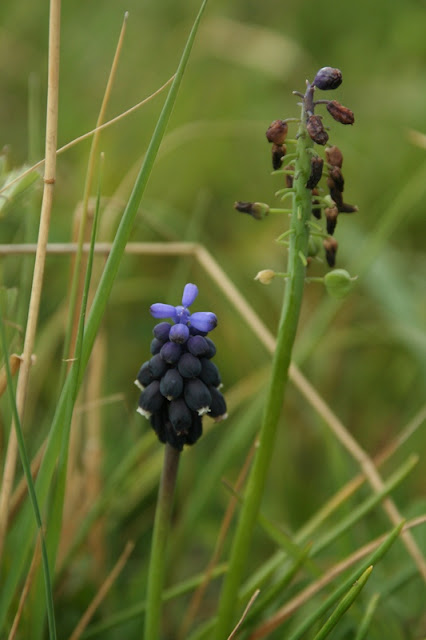Today we visited the historical sites of Paphos: a
holy hermit's
last resting place, the ancient ptolemic
necropolis and the
spectacular mosaics of the Paphos headland.
At Paphos, the most obvious result of last night's rain was a massive fall of wagtails: the headland was covered in flocks feeding along the paths and flushing in large numbers from the vegetation. Mostly Black-headed Wagtails, but with plenty of Blue-headed (at a ratio of about 1:20), lots of intriguing intergrades presumably on their way to Romania or the Ukaraine, and at least three male Grey-headed Wagtails, as well as plenty of White Wagtails and a couple of Tawny Pipits amongst them. Other migrants here were a pair of Short-toed Larks, a handful of wheatears and three lovely Cretzschmar's Buntings.
Earlier, we'd stopped in an area of orchards, where a small population of
Tulipa agenensis just hangs on around the edges of cultivation, together with
Muscari neglectum. Oh yes, and those wheatears... a roadside Cyprus Wheatear, a handful each of Northern and Isabelline Wheatears at both Tombs of the Kings and Paphos Headland, a male Eastern Black-eared Wheatear in the orchard at the hotel and best of all, yet another Desert Wheatear, this time a female on the barren 'beach' at Tombs of the Kings. Once again I was only carrying my 'plant lens'...
Isabelline Wheatear (yesterday, at the Sanctuary of Apollon Hylates)
Cyprus Wheatear (yesterday, again at the Sanctuary of Apollon Hylates)
Eastern Black-eared Wheatear, this evening, in the hotel grounds
our male Desert Wheatear from earlier in the week (photo by tour participant Steve Pickersgill)
Another of Steve's photos: one of today's Cretzschmar's Buntings, at Paphos Headland
Muscari neglectum
Tulipa agenensis
an impressive display of Cylcamen persicum at the Tombs of the Kings























































